 Our first High Five of 2020 comes from Neil Sheasby songwriter and bass player with Stone Foundation. It’s become a bit of a ritual now and this is Neil’s seventh consecutive contribution to this end of year celebration – and it’s always the first one to hit the inbox. Lockdown and Lockdown Lite have caused major problems for Stone Foundation; they’re a working live band and virtually everything apart from a weekend of socially-distanced gigs in the Midlands has been cancelled/postponed. The band has pushed on with the release of its 2020 Top 40 album “Is Love Enough?” and they’re now working on the next one, proving that this year doesn’t have to be defined by the negatives. Anyway, over to Neil:
Our first High Five of 2020 comes from Neil Sheasby songwriter and bass player with Stone Foundation. It’s become a bit of a ritual now and this is Neil’s seventh consecutive contribution to this end of year celebration – and it’s always the first one to hit the inbox. Lockdown and Lockdown Lite have caused major problems for Stone Foundation; they’re a working live band and virtually everything apart from a weekend of socially-distanced gigs in the Midlands has been cancelled/postponed. The band has pushed on with the release of its 2020 Top 40 album “Is Love Enough?” and they’re now working on the next one, proving that this year doesn’t have to be defined by the negatives. Anyway, over to Neil:
2020 – A new decade, boundless opportunity, a fresh optimism prevailed. Even its digits seemed to herald in some futuristic promise of a new dawn. Wipe the slate clean of social media tribalism & recent divides over the political warfare of nationalism, Brexit and the lack of a clear, forward, progressive vision.
2020 – The turning of a new page. Positive thinking. A restoration of respect. And then…
Do I need to go on? Rip it up & start again. It’s good to try and dig out a few simple pleasures here once again for the annual High Fives feature…
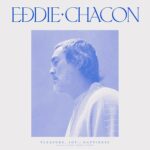 1) I’ll begin in the obvious place. Music. This year’s soundtrack. Thankfully music always has the ability to inspire and lift you; in the most testing of times, especially so. The real surprise package of the year came courtesy of the most unlikely of sources, an album called “Pleasure, Joy and Happiness” by Eddie Chacon.
1) I’ll begin in the obvious place. Music. This year’s soundtrack. Thankfully music always has the ability to inspire and lift you; in the most testing of times, especially so. The real surprise package of the year came courtesy of the most unlikely of sources, an album called “Pleasure, Joy and Happiness” by Eddie Chacon.
Previously a name unknown to me (at least that’s what I presumed), I’d chanced upon this record whilst navigating my way around Spotify and it just immediately drew me in. It’s sparse, direct and soulful. Of course I naturally assumed it was a new artist, that’s the problem with platforms such as Spotify, you don’t get that much info about a release but I’ve never been shy of doing a bit of homework and it came as a great revelation that Eddie Chacon turned out to be Eddie as in one half of naff 90’s chart toppers Charles & Eddie who had a global smash with “Would I Lie to You” in 1992.
Eddie had abandoned the music industry in the intervening years and this was his humble return after 30 plus years away. I think his story made me love the album even more…
 2) Due to the circumstances I’ve had even more time to read and have really enjoyed books such as “Yeah Yeah Yeah” – Bob Stanley’s epic journey through the story of modern pop music, I thought Pete Paphides’ book was a glorious reflection, Chris Frantz’s “Remain in Light” I enjoyed even if it veered off the beaten track factually somewhat, and more recently I tackled John Cooper Clarke’s biography which possibly gets my vote for book of the year (musically related at least)
2) Due to the circumstances I’ve had even more time to read and have really enjoyed books such as “Yeah Yeah Yeah” – Bob Stanley’s epic journey through the story of modern pop music, I thought Pete Paphides’ book was a glorious reflection, Chris Frantz’s “Remain in Light” I enjoyed even if it veered off the beaten track factually somewhat, and more recently I tackled John Cooper Clarke’s biography which possibly gets my vote for book of the year (musically related at least)
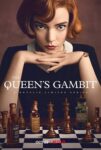 3) TV highlight – “The Queen’s Gambit”
3) TV highlight – “The Queen’s Gambit”
What a refreshing series! Beautifully cast and filmed, stylish down to a tee. Great story, great script. Wonderful acting and even managed to make Chess seem hip.
Highly recommended if you haven’t seen it.
 4) An indulgence on my part I know but this was a major highlight in an otherwise uneventful 2020…the rise and return to top flight football of my beloved Leeds United. Obviously it had been a long time coming (16 years to be precise) and it took an Argentinian bespectacled genius who perches on a bucket to enable a path back to glory.
4) An indulgence on my part I know but this was a major highlight in an otherwise uneventful 2020…the rise and return to top flight football of my beloved Leeds United. Obviously it had been a long time coming (16 years to be precise) and it took an Argentinian bespectacled genius who perches on a bucket to enable a path back to glory.
It’s been a revelation watching football again under Bielsa and reignited my love for the game. I’m so happy for my kids too, they never wavered in their support for Leeds but I’m sure there were times when they must have thought “why do we support this lot Dad?”
Hopefully Leeds Utd can remain in the top flight of English football now and continue the ascent. Promotion to the Prem was a big moment in our house. I really can’t wait for the Trans-Pennine skirmishes with Man Utd again.
 5) Recording. Although our touring schedule has been decimated it has meant more time and opportunity to create & write. Our last album “Is Love Enough?” was actually completed quite some time ago so since then we’ve been chipping away at writing the next one. Lockdown just probably accelerated the process so we have been able to begin the recording of what may well become another Stone Foundation record, it’s been good to fill the void with creativity and keep the wheels in motion in that respect.
5) Recording. Although our touring schedule has been decimated it has meant more time and opportunity to create & write. Our last album “Is Love Enough?” was actually completed quite some time ago so since then we’ve been chipping away at writing the next one. Lockdown just probably accelerated the process so we have been able to begin the recording of what may well become another Stone Foundation record, it’s been good to fill the void with creativity and keep the wheels in motion in that respect.
Obviously we all sincerely hope that there’s a way back to gigging as we have always known it without compromise or restrictions, it’s important we don’t get sold down the river under the guise of a “new normal”, we are all social animals and we need that communal connection.
It’s what SF events thrive upon.
My son Lowell (who’s 17 now) is studying music production at college and he’s been working on his own music through lockdown so I’ve been helping out and collaborating on that too which for me has been like starting out again as a teenager, learning new & different ways to create and record, all done in his bedroom too. The spirit prevails and the baton gets passed on…I like that.
Ok, call me obsessive if you like but as well as listening to a lot of albums and going to as many gigs as I can, I also read the odd book or two about music and popular culture and many of those are worth sharing with anyone who checks out MusicRiot regularly. This list was difficult to pin down to five from the start, but it became even more difficult on Christmas Day when I was given a copy of the Donald Fagen memoir/tour diary/article compilation, “Eminent Hipsters”. So I guess that’s a pretty good place to start.
“Eminent Hipsters” – Donald Fagen
 Where do I start with Donald Fagen? With Walter Becker, he was half of one of my favourite 70s bands, Steely Dan and then went on to release the classic solo album, “The Nightfly” in 1982, followed (not too closely) by “The Kamakiriad” in 1993. You’ve probably guessed by now, I’m a bit of a fan. “Eminent Hipsters” is partly an explanation, through a series of articles, of the factors which influenced the Steely Dan sound (cool jazz, cop dramas and wise-ass comedians) and the Donald Fagen solo sound (science fiction and mid-century paranoia). If you love the music, you’ll be fascinated by these observations about its roots. The second part of this slim volume is devoted to Fagen’s diary from the 2012 “Dukes of September Rhythm Revue” tour which is, by turn, snarky, moving, insightful and downright hilarious.
Where do I start with Donald Fagen? With Walter Becker, he was half of one of my favourite 70s bands, Steely Dan and then went on to release the classic solo album, “The Nightfly” in 1982, followed (not too closely) by “The Kamakiriad” in 1993. You’ve probably guessed by now, I’m a bit of a fan. “Eminent Hipsters” is partly an explanation, through a series of articles, of the factors which influenced the Steely Dan sound (cool jazz, cop dramas and wise-ass comedians) and the Donald Fagen solo sound (science fiction and mid-century paranoia). If you love the music, you’ll be fascinated by these observations about its roots. The second part of this slim volume is devoted to Fagen’s diary from the 2012 “Dukes of September Rhythm Revue” tour which is, by turn, snarky, moving, insightful and downright hilarious.
Donald Fagen writes in an instantly-identifiable style betraying a debt to Raymond Chandler and Dashiell Hammett, which sneaks in when describing Audrey Hepburn in “Breakfast at Tiffany’s” as getting :”out of that cab on Fifth Avenue in a black dress and pearls in the early morning, I wanted to sip her through a straw”. It’s beautifully written and you can get through it in a few hours; it takes 170 pages to deliver a message that most rock biographies take at least five times as long to get over.
“Bedsit Disco Queen: How I Grew Up and Tried to be a Pop Star” – Tracey Thorn
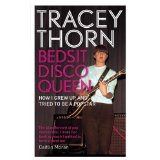 If Donald Fagen’s prose style is easily identifiable, then Tracey Thorn’s is even more so. I’m always impressed when musicians get this right (Peter Hook and Luke Haines also do it particularly well) and, from the first paragraph, this is pitch-perfect ‘Popstar Trace’. The book takes us from the Marine Girls beginnings through the EBTG false starts and eventual success to the beautiful Massive Attack vocals (I’m biased, but you should read about the origins of the modern classic, “Protection” here) and the worldwide Todd Terry-remixed success of “Missing”.
If Donald Fagen’s prose style is easily identifiable, then Tracey Thorn’s is even more so. I’m always impressed when musicians get this right (Peter Hook and Luke Haines also do it particularly well) and, from the first paragraph, this is pitch-perfect ‘Popstar Trace’. The book takes us from the Marine Girls beginnings through the EBTG false starts and eventual success to the beautiful Massive Attack vocals (I’m biased, but you should read about the origins of the modern classic, “Protection” here) and the worldwide Todd Terry-remixed success of “Missing”.
Tracey’s style is perfectly self-deprecatory; you never feel a hint of false modesty and the mentions of famous musicians are always very matter-of-fact, including the story about waiting to pick the kids up from school and being shouted at by George Michael from a Range Rover. This is a wonderful memoir from a genuine pop star.
“Yeah, Yeah, Yeah: The Story of Modern Pop” – Bob Stanley
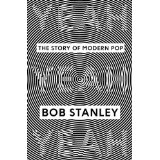 It’s obvious from the outset that this is actually a companion piece to the classic 2012 St Etienne album, “Words and Music”. The album was a voyage through the history of British pop music and the book is an extended verbal remix of the ground covered by the album. What’s equally obvious is that Bob Stanley is both an enthusiast and an insider, which gives him a unique perspective on his subject. He aims to show the links between different styles using not just the music, but also sociological and technological developments. If you’re interested in the history of pop music and you’ve done a bit of research, you might disagree with some of his pronouncements, but it’s a big book and you’ll probably agree with ninety per cent of them.
It’s obvious from the outset that this is actually a companion piece to the classic 2012 St Etienne album, “Words and Music”. The album was a voyage through the history of British pop music and the book is an extended verbal remix of the ground covered by the album. What’s equally obvious is that Bob Stanley is both an enthusiast and an insider, which gives him a unique perspective on his subject. He aims to show the links between different styles using not just the music, but also sociological and technological developments. If you’re interested in the history of pop music and you’ve done a bit of research, you might disagree with some of his pronouncements, but it’s a big book and you’ll probably agree with ninety per cent of them.
The book takes the first NME chart in 1952 as its starting point (which is logical and not controversial) and the end of vinyl as a chart force in 1993 as its end point, when the first Number One singles not to have been released as a 7” single or (a few months later) on vinyl at all topped the charts (if you want to know what they are, you can buy the book ). It’s a slightly more controversial choice but still with a logical basis for someone who grew up in the age of vinyl. The book has an authority derived from Bob Stanley’s experience as a writer and member of a very successful pop group but never slips into the socio-cultural academic approach of, for example, Simon Reynolds. The theme that underpins everything else in this book is that Bob Stanley is still a fan who wants you to come round and listen to his records, and that makes this an unmissable book.
“Here Comes Everybody: The Story of the Pogues” – James Fearnley
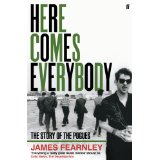 I’ve always been a fan of the “inside story” biography, particularly those that aren’t ghost-written attempts at cultural revisionism. This memoir by James Fearnley is, at times, brutally and crushingly honest about members of The Pogues and he doesn’t spare himself either. The book begins by setting the scene with Shane MacGowan’s departure from the band in 1991 before moving back to Fearnley’s initial meeting with MacGowan at an audition for The Nips in 1980.
I’ve always been a fan of the “inside story” biography, particularly those that aren’t ghost-written attempts at cultural revisionism. This memoir by James Fearnley is, at times, brutally and crushingly honest about members of The Pogues and he doesn’t spare himself either. The book begins by setting the scene with Shane MacGowan’s departure from the band in 1991 before moving back to Fearnley’s initial meeting with MacGowan at an audition for The Nips in 1980.
The book is a (mainly) unsentimental account of the rise and fall of The Pogues from the viewpoint of someone close enough to see everything but with enough distance to retain some objectivity. From the chaotic managerless beginnings through the unpopular but successful stewardship of Frank Murray, the story is underpinned at all times by MacGowan’s unpredictability and seemingly random self-destructive urges. James Fearnley tries very hard to balance the singer’s inexcusable behaviour against the genius of the songs, but it’s up to you if you buy that line; I certainly don’t. My only criticism is that James Fearnley spends a little too much time trying to emphasise the fact that he’s a writer and occasionally introduces unnecessarily florid prose to prove it; putting that aside, it’s still a winner.
“Sounds like London: 100 Years of Black Music in the Capital” – Lloyd Bradley
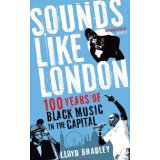 Bear with me for a minute here; this will all make sense presently. Earlier this year I read “How Soon is Now?: The Madmen and the Mavericks who made Independent Music 1975-2005” by Richard King. It’s a very good book and a must for geeks like us, but it attracted a lot of criticism because it didn’t touch on the black music scene. Richard King was even accused, pathetically, of racism in some quarters; you might even have read about it. Personally, I prefer to read authors who write about subjects they understand and that really inspire them; if Richard King didn’t have the expertise, contacts or inspiration to write about the black music scene, then Lloyd Bradley certainly did.
Bear with me for a minute here; this will all make sense presently. Earlier this year I read “How Soon is Now?: The Madmen and the Mavericks who made Independent Music 1975-2005” by Richard King. It’s a very good book and a must for geeks like us, but it attracted a lot of criticism because it didn’t touch on the black music scene. Richard King was even accused, pathetically, of racism in some quarters; you might even have read about it. Personally, I prefer to read authors who write about subjects they understand and that really inspire them; if Richard King didn’t have the expertise, contacts or inspiration to write about the black music scene, then Lloyd Bradley certainly did.
The title is a little misleading; there’s very little about pre-1950s black music, and it also deals with regional English offshoots from the London scene but those aren’t criticisms, just observations. The reason for the comparison with Richard King’s book is that one of Lloyd Bradley’s recurring themes is that black British music has always developed and prospered healthily out of the mainstream when produced and distributed independently.
Once the book reaches the point where Lloyd Bradley can introduce interviews with the players who made black British music happen (the steel pan players, the jazzers, the sound system pioneers, the Britfunk players and the mainstream crossovers Eddy Grant, Janet Kay, Jazzie B and the rest), the narrative really takes off with stories of the sound systems and records being sold out of the back of a car and distributed around the country in the same way. Lloyd Bradley takes us through calypso, ska, reggae, lovers rock, dub, britfunk, 98 bpm, trip hop, jungle, d’n’b, UK garage, dubstep and grime along with a host of short-lived one-way streets with an unassuming and easy authority that is very seductive. If you want an introduction to black British music, this is the book for you.
OK, spoilers alert; I’ve relented. I’ll tell you that the chart-toppers Bob Stanley refers to in 1993 and 1995 respectively are Culture Beat’s “Mr Vain” and Celine Dion’s “Think Twice”, but you should still read the book. Actually you should read all of these books.


